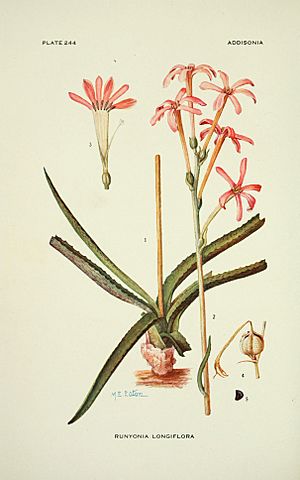Amole de río facts for kids
Quick facts for kids Amole de río |
|
|---|---|
 |
|
| Conservation status | |
| Scientific classification | |
| Genus: |
Agave
|
| Species: |
longiflora
|
| Synonyms | |
|
Manfreda longiflora (Rose)Verh.-Will. |
|
Agave longiflora is a unique flowering plant. It belongs to the Asparagaceae family, which also includes asparagus! This plant grows naturally in the Lower Rio Grande Valley in Texas, United States. You can also find it in northern Tamaulipas, Mexico.
People know this plant by several names. Some common names are amole de río, longflower tuberose, and Runyon's huaco.
Contents
Discovering Agave longiflora
How the Plant Got Its Name
A botanist and photographer named Robert Runyon (1881–1968) played a big part in discovering this plant. In 1921, he sent samples of the plant to the New York Botanical Garden.
Because of his work, another botanist, Joseph Nelson Rose, first named the plant Runyonia longiflora. This name honored Robert Runyon. Later, scientists moved the plant into the genus Manfreda. Today, Manfreda is part of the larger Agave group. So, the plant is now officially called Agave longiflora. It was once known as Manfreda longiflora.
What Does Agave longiflora Look Like?
Agave longiflora is a type of plant that lives for many years. It grows from underground stems called rhizomes. This means it can spread out and form new plants.
The plant has 3 to 7 leaves that lie flat on the ground. These leaves grow in a circle, like a rosette. Imagine a rose, but with plant leaves instead of petals!
Where Does Agave longiflora Grow?
This plant likes to live in dry, warm places. You can find it on hills, flat areas called terraces, and slopes. Its home is in a semi-arid region called the Tamaulipan mezquital. Semi-arid means it's a bit dry, but not a full desert. This area is known for its unique plants and animals.


